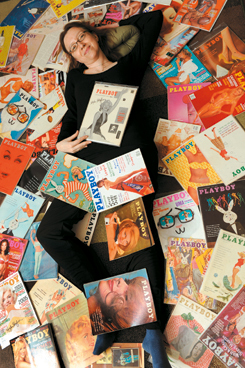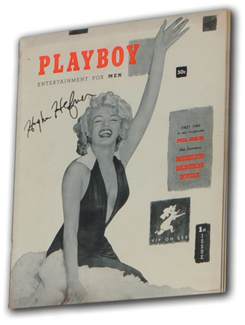Beyond the Quads
Centerfold central
An unlikely hobby yields a valuable sociological archive.
By Benjamin Recchie, AB’03
When Wired magazine created a 2009 infographic on the body mass index of Playboy centerfolds, headlined “Today’s playmates are more like anime figures than real humans,” it misattributed its data to research done at the University of Chicago Library. In fact, the database of Playboy playmates, including their birthdates and measurements, was a personal project done by Peggy Wilkins, AB’92. A Unix administrator at the Regenstein, she used the data—which she painstakingly entered herself, based on her complete archive of Playboy magazine—to teach herself to use a database developed by a colleague.
Like Playboy itself, the story of Wilkins’s collection starts with Marilyn Monroe. As an adolescent, Wilkins was fascinated with the iconic actress. In the course of hunting for photographs, she came upon the 25th anniversary issue of Playboy, a 500-page compilation of its best material and, in her opinion, “one of the best issues of any magazine ever published.” It contained pictures of Monroe that Wilkins had never seen, but what really transfixed her was the quality of the photographs and the other features.
In January 1980, at age 14, Wilkins bought her first newsstand issue and hasn’t missed one since. Even as a minor she had little trouble purchasing the magazine, since clerks were watching for teenage boys, not girls. Wilkins also collected back issues, scanning classified ads and visiting used bookstores. Not every magazine passed muster: “I couldn’t take one that’s missing a page or has a coupon clipped or something like that.”
In 1983, Wilkins brought her growing collection to Chicago, where she majored in chemistry before changing to music. Despite having attended college during the height of the culture wars, she says she never had to defend her collection—either to social conservatives or antipornography feminists. “It’s not pornography,” she says. “It’s nudity.” Her friends were indifferent to her hobby, including her live-in boyfriend, who ignored the neat row of boxes on the floor: “He wasn’t into photography,” says Wilkins. “He was more science-oriented.”
It took 24 years, but in November 2004—with the addition of the November 1954 issue—the collection was complete. Today Wilkins keeps her collection up to date by buying each issue off the newsstand as soon as it’s released. One copy of each issue is kept pristine, going into plastic covers, though Wilkins usually has multiple copies of back issues (sometimes as many as five; duplicates are fair game for her if the issue has a model’s autograph). She conservatively estimates the collection occupies 60 linear feet of bookshelves in her apartment. It’s far from the only complete collection in existence; although she can’t speculate on how many exist, she notes even most libraries don’t have one, since few subscribed to the earliest issues.
Despite being marketed as “entertainment for men,” Playboy appeals to Wilkins in a variety of ways. (The idea that the “entertainment” consists solely of erotic photography, she says, is widely held but largely incorrect.) There is the quality of the photography, in particular the centerfolds, a concept pioneered by Hugh Hefner. In the early days, the model would hold the same pose day after day for a week, while hundreds of 8x10 film images were produced. “They’re exceptional images in the way they’re produced, conceived, staged, and even laid out on the page,” says Wilkins. Wilkins also shares Hefner’s interest in American popular culture, particularly “movie history and glamour and retro things.”
Although the core content of Playboy hasn’t changed, she sees the realities of the difficult market for print eroding its quality. Once, each issue included four pieces of fiction; today, that number is one. The subjects of photo spreads are more likely to be chosen for their celebrity status. Even the covers, she says, have gone downhill: “It’s no longer an attractive or creative image in terms of design. It’s just trying to be eye-catching.”
When the 82-year-old editor-in-chief Hefner retires, Wilkins says, corporate parent Playboy Enterprises may decide to radically revamp the magazine or even discontinue it in favor of its more profitable online ventures. “Playboy’s orientation toward pinups, their history, romance—all those things are a kind of reflection of Hugh Hefner’s interests and his age,” says Wilkins. “When he’s gone, I doubt they will stay the same.”

